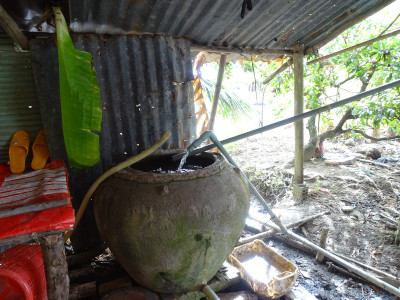Dynamics of ground- and surfacewater quality caused by intensive land subsidence, climate- and landuse changes in the southern Mekong Delta, Vietnam
- Betreuung:
Prof. Dr. Stefan Norra
- Bearbeitung:Jonas Bauer
River water sampling December 2018 River in Ca Mau Province Small port at the west coast of Ca Mau
This work aims to contribute to the development of solutions and mitigation measures for the environmental challenges due to natural and anthropogenic processes in Ca Mau Province, which is located in the most southern part of the low lying Mekong Delta (MD) in southern Vietnam, the third largest delta on earth.
The fast development of population, industry and mainly agriculture as well as aquaculture puts water resources under pressure and negative environmental impacts can be observed now. Groundwater overexploitation was recently linked to severe local land subsidence of several centimeters a year, which in combination with additive processes such as natural compaction of the upper sediment layers, a decline of fluvial sediment supply transported by the Mekong River due to upstream dam constructions as well as sea level rise due to global climate change threaten the low lying MD in its very existence. Ca Mau Province is additionally facing heavy coastal and river erosion and salinization. Overall, the problems can be summarized as a progressive “loss of land and fresh water”.
Several field campaigns for sampling and field investigations make up the base of this work. Obtained geochemical data will be statistically evaluated to get insights of ongoing processes and to model ground- and surfacewater quality dynamics with the aim to develop recommendations regarding environmental challenges.
This work is done in the frame of the project „ViWaT – Vietnam Water Technology“, which aims to develop integrated solutions for the sustainable development in the Mekong Delta.
Metal huts at the riverside at the westcoast Groundwater storage tank Combined rice and fish pond


skal2.JPG)
skal22.JPG) River water sampling December 2018 River in Ca Mau Province Small port at the west coast of Ca Mau
River water sampling December 2018 River in Ca Mau Province Small port at the west coast of Ca Mau2.JPG)

 Metal huts at the riverside at the westcoast Groundwater storage tank Combined rice and fish pond
Metal huts at the riverside at the westcoast Groundwater storage tank Combined rice and fish pond